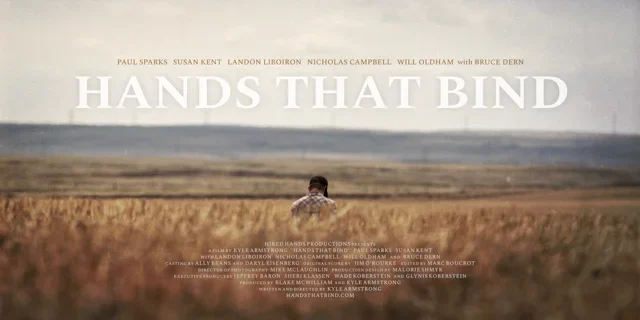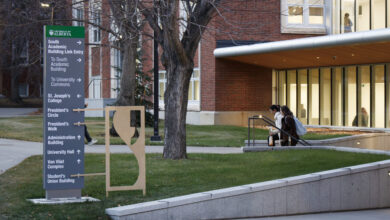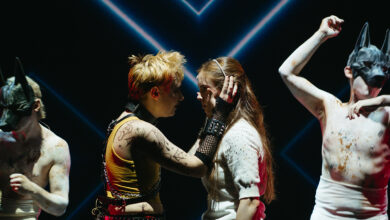Movie Review: Hands That Bind
Kyle Armstrong’s prairie-gothic drama creates an eerie twist on the simple Alberta 1980s farm life.
 Supplied
SuppliedHave you ever had the feeling that something is off, and you can’t quite pinpoint why? Coupled with subtle disturbing effects, I encountered this feeling of slight confusion while watching Hands That Bind.
Hands that Bind, directed by Kyle Armstrong, is a prairie-gothic drama set in Alberta in the 1980s. The story follows Andy Hollis (Paul Sparks), who works on a farm owned by Mac Longridge (Nicholas Campbell). When Mac’s son, Dirk Longridge (Landon Liboiron), returns home to take over the farm, he throws Andy’s life off course.
Over the course of the movie, tensions run high between Andy and Dirk. They are the antithesis of one another, and both know it. Andy puts in hours at the farm and keeps up good relations with Mac and surrounding neighbours. However, Dirk is cold toward Andy and his wife, Susan Hollis (Susan Kent), with no interest in farming or his father’s land.
The movie starts off slow, and I had a bit of trouble getting into it. However, after watching the movie in its entirety, I realize the pacing is quite gradual overall. Although this may deter some people, I advise to hold out — because things take a turn.
Andy is a difficult main character. He does the bare minimum in terms of being a good husband and father. He constantly nags on his children and is passive toward his wife — sometimes even publicly. At a dance, Dirk dances with Susan while Andy watches. When Andy and Susan are home that night, they slow-dance in the living room together and Susan asks why he won’t dance with her in public. He doesn’t respond.
Throughout the film, Andy struggles with what it means to be a strong working man and a provider for his family. When it seems that Dirk will replace Andy on the farm, Susan offers to go back to work after being a stay-at-home mom for over 10 years. Andy is in disbelief about this and refuses to hear her out — even when she says she could earn just as much as him. This really highlighted Andy’s stubbornness and his paranoia about being a strong working man. It made me even more annoyed with him, and overall less sympathetic toward his situation.
The sense of eeriness increased as the film progressed. At times, certain depictions confused me. Near the beginning, Andy and Mac come across a dead cow in their field. However, upon further inspection, they realize someone carefully removed certain body parts from the cow. Mac remarks that the incision on the cow’s jawline is “almost like a surgeon’s cut.” Strangely, this was never really alluded to again.
There are similar, uneasy moments that the film makes little attempt to explain or develop. Andy and Mac later come across another dead cow — this time it’s hanging upside-down in a tree. Additionally, Andy sees helicopter lights at night and unrecognizable cars passing down the road in the day. From his expressions it is clear he thinks these events are strange. Therefore, I am led to think the same. Yet, there is no attempt to explain the purpose behind these uneasy moments.
Along with the many unnerving scenes such as these, the tension between Andy and Dirk also becomes heightened. As the movie progresses, Andy’s dislike towards Dirk and his unsatisfactory feelings toward his manhood become more agitated. His ability to conceal his distaste towards Dirk is practically non-existent near the end of the movie. The strange fate of the cows, along with the growing hatred from Andy toward Dirk, heightened my feelings of paranoia and discomfort.
In terms of the cinematography, there were techniques that contributed to certain themes of the film. There were numerous shots of farm fields and horizons that went on for long periods of time. To me, this symbolized how trapped Andy was within himself and the mundane nature of working on the farm. I didn’t mind them for the most part, but after a while they felt a bit repetitive. Although, maybe that was the point.
At one point, there is a shot of Andy from above while he is laying on his back repairing the kitchen sink from underneath. The camera focuses on this one position for nearly an entire minute. At the time I didn’t understand the significance of the shot’s length. Yet after watching the final scene, I realized it was intentional foreshadowing. It was a brilliant detail. These are just some examples of techniques used to enhance the cinematography — and the storylines as well.
Hands That Bind is a slow-paced, slightly disturbing film that will have you questioning the reasoning behind certain cinematic and stylistic choices. Yet it isn’t really until the very end that you realize the all-encompassing themes — and how these choices were mostly intentional.
Hands That Bind will screen at Metro Cinema on November 24, paired with a Q&A facilitated by Taproot Edmonton.




